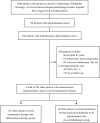Efficacy and Safety of Local Radiotherapy to All Oligometastatic Sites in Elderly Patients with Metachronous Oligometastatic Cancers After Initial Treatment for the Primary Tumor
- PMID: 34955655
- PMCID: PMC8694577
- DOI: 10.2147/CMAR.S345871
Efficacy and Safety of Local Radiotherapy to All Oligometastatic Sites in Elderly Patients with Metachronous Oligometastatic Cancers After Initial Treatment for the Primary Tumor
Abstract
Background and purpose: This study aimed to investigate the efficacy and safety of maintenance therapy combined with local radiotherapy at all oligometastatic sites (LRTOS) in elderly patients with metachronous oligometastatic cancers (MOC).
Patients and methods: A total of 242 elderly patients with MOC (≤5 metastases) and primary tumor well controlled after definitive treatment was retrospectively analyzed between August 2014 and February 2020 at Beijing Geriatric Hospital and Air Force General Hospital. Patients were divided into maintenance therapy group (maintenance therapy alone) and local radiotherapy group (maintenance therapy combined with LRTOS).
Results: There were 86 patients in the local radiotherapy group and 156 patients in the maintenance therapy group. The median length of follow-up was 36 months (range, 8.0-62 months). Median overall survival (mOS) was 25 months (95% CI: 21.1-28.9) in the local radiotherapy group and 16 months (95% CI: 14.5-17.6) in the maintenance therapy group (p < 0.001). Multivariate analyses demonstrated that LRTOS (hazard ratio (HR) = 0.49, 95% confidence interval (CI): 0.35-0.67, p < 0.001), good Eastern Cooperative Oncology Group Performance Status (ECOG PS, HR = 0.69, 95% CI: 0.49-0.97, p = 0.032), longer duration between diagnosis of primary tumor and occurrence of progression (HR = 0.87, 95% CI: 0.78-0.97, p = 0.015), and subsequent systemic treatment (HR = 0.52, 95% CI: 0.38-0.72, p < 0.001) were independent predictors of good OS. In patients who did not receive subsequent systemic treatment, their mOS was 21 months (95% CI: 12.8-29.2) for those treated with LRTOS and 14 months (95% CI: 11.4-16.6) for those who did not receive local radiotherapy (p = 0.001). Further multivariate analysis showed that LRTOS was the only independent factor for predicting good OS (HR = 0.47, 95% CI: 0.26-0.83, p = 0.010). Patients with metachronous oligometastatic lung cancer, colorectal cancer, prostate cancer, and breast cancer had higher survival benefits following LRTOS. Most patients suffered from grade 1-2 toxicities, but no treatment-related death was recorded.
Conclusion: This retrospective study shows that elderly patients with MOC treated with LRTOS may have better survival outcomes.
Keywords: elderly patients; local radiotherapy; metachronous oligometastatic cancers; residual disease.
© 2021 Hu et al.
Conflict of interest statement
The authors have declared no conflicts of interest.
Figures






Similar articles
-
First-Line Tyrosine Kinase Inhibitors Combined With Local Consolidative Radiation Therapy for Elderly Patients With Oligometastatic Non-Small Cell Lung Cancer Harboring EGFR Activating Mutations.Front Oncol. 2022 Jan 25;12:766066. doi: 10.3389/fonc.2022.766066. eCollection 2022. Front Oncol. 2022. PMID: 35145913 Free PMC article.
-
Long-term outcomes in radically treated synchronous vs. metachronous oligometastatic non-small-cell lung cancer.BMC Cancer. 2016 Jun 2;16:348. doi: 10.1186/s12885-016-2379-x. BMC Cancer. 2016. PMID: 27255302 Free PMC article.
-
Stereotactic radiotherapy or metastasectomy for oligometastatic esophagogastric cancer: A nationwide population-based cohort study.Clin Transl Radiat Oncol. 2022 Aug 24;37:109-115. doi: 10.1016/j.ctro.2022.08.012. eCollection 2022 Nov. Clin Transl Radiat Oncol. 2022. PMID: 36186924 Free PMC article.
-
Changing equipoise in the landscape of radiation for oligometastatic lung cancer.Transl Lung Cancer Res. 2019 Sep;8(Suppl 2):S184-S191. doi: 10.21037/tlcr.2019.07.09. Transl Lung Cancer Res. 2019. PMID: 31673523 Free PMC article. Review.
-
Safety and Survival Rates Associated With Ablative Stereotactic Radiotherapy for Patients With Oligometastatic Cancer: A Systematic Review and Meta-analysis.JAMA Oncol. 2021 Jan 1;7(1):92-106. doi: 10.1001/jamaoncol.2020.6146. JAMA Oncol. 2021. PMID: 33237270 Free PMC article.
Cited by
-
Role of Local Treatment for Oligometastasis: A Comparability-Based Meta-Analysis.Cancer Res Treat. 2022 Oct;54(4):953-969. doi: 10.4143/crt.2022.329. Epub 2022 Aug 16. Cancer Res Treat. 2022. PMID: 35989655 Free PMC article.
-
Stereotactic Body Radiotherapy and Immunotherapy for Older Patients with Oligometastases: A Proposed Paradigm by the International Geriatric Radiotherapy Group.Cancers (Basel). 2022 Dec 30;15(1):244. doi: 10.3390/cancers15010244. Cancers (Basel). 2022. PMID: 36612239 Free PMC article.
References
LinkOut - more resources
Full Text Sources

